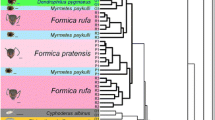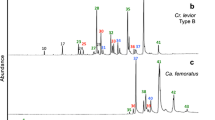Abstract
Workers of most social insects can distinguish between nestmates and non-nestmates, and actively attack the latter if they attempt to intrude into the nest or surrounding territory. Nevertheless, there are many records of heterospecific organisms living within the nests of social insects, and they are thought to gain access through chemical mimicry. The salticid spider Cosmophasis bitaeniata lives within the leaf nests of the ant Oecophylla smaragdina, where it preys on the ant larvae. We investigated, using behavioural bioassays and chemical analyses, whether the previously reported resemblance of the cuticular hydrocarbons of ant and spider was colony-specific. Behavioural experiments revealed that the spiders can distinguish between nestmate and non-nestmate major workers and are less inclined to escape when confined with ants that are nestmates. More significantly, C. bitaeniata were more likely to capture ant larvae from nestmate minor workers than non-nestmate minor workers. The chemical analyses revealed that the cuticular hydrocarbon profiles of the spiders and the major workers of the ant colonies were colony-specific. However, the hydrocarbon profiles of C. bitaeniata do not match those of the major workers of O. smaragdina from the same colony. Perhaps the colony-specific cuticular hydrocarbon profiles of C. bitaeniata function to obtain prey from the minor workers rather than avoid eliciting aggression from the major workers.






Similar content being viewed by others
References
Aitchison J (1986) The statistical analysis of compositional data. Chapman, London
Allan RA, Elgar MA (2001) Exploitation of the green tree ant Oecophylla smaragdina by the salticid spider Cosmophasis bitaeniata. Aust J Zool 49:129–139
Allan RA, Capon RJ, Brown V, Elgar MA (2002) Mimicry of host cuticular hydrocarbons by a spider that preys on ant larvae. J Chem Ecol 28:835–848
Blum MS (1969) Alarm pheromones. Annu Rev Entomol 14:57–80
Bonavita-Cougourdan A, Clement J-L, Lange C (1993) Functional subcaste discrimination (foragers and brood-tenders) in the ant Camponotus vagus Scop.: polymorphism of cuticular hydrocarbon patterns. J Chem Ecol 19:1461–1477
Boulay R, Katzav-Gozansky T, Hefetz A, Lenoir A (2004) Odour convergence and tolerance between nestmates through trophallaxis and grooming in the ant Camponotus fellah (Dalla Torre). Insect Soc 51:55–61
Brown WV, Watson JAL, Lacey MJ, Morton R, Miller LR (1996) Composition of cuticular hydrocarbons in the Australian harvester termite Drepanotermes perniger (Isoptera: Termitidae): variation among individuals, castes, colonies and locations. Sociobiology 27:181–197
Cushing PE (1995) Description of the spider Masoncus pogonophilus (Araneae, Linyphiidae): a harvester ant myrmecophile. J Arachnol 23:55–59
Cushing PE (1997) Myrmecomorphy and myrmecophily in spiders: a review. Fla Entomol 80:165–193
Dahbi A, Cerdá X, Hefetz A, Lenoir A (1996) Social closure, aggressive behaviour, and cuticular hydrocarbon profiles in the polydomous ant Cataglyphis iberica (Hymenoptera, Formicidae). J Chem Ecol 22:2173–2186
Dettner K, Liepert C (1994) Chemical mimicry and camouflage. Annu Rev Entomol 39:129–154
D’Ettorre P, Mondy N, Lenoir A, Errard C (2002) Blending in with the crowd: social parasites integrate into their host colonies using a flexible chemical signature. Proc R Soc Lond B 269:1911–1918
Elgar MA (1993) Inter-specific associations involving spiders. Mem Queensl Mus 33:411–430
Elgar MA, Allan RA (2004) Spider chemical mimics acquire colony-specific cuticular hydrocarbons from their ant model prey. Naturwissenschaften 91:143–147
Foelix RF (1982) Biology of spiders. Harvard University Press, Cambridge
Hölldobler B (1983) Territorial behaviour in the green tree ant (Oecophylla smaragdina). Biotropica 15:241–250
Hölldobler B, Wilson EO (1990) The ants. Harvard University Press, Cambridge
Howard RW, Perez-Lachaud G, Lachaud JP (2001) Cuticular hydrocarbons of Kapala sulcifacies (Hymenoptera: Eucharitidae) and its host, the ponerine ant Ectatomma ruidum (Hymenoptera : Formicidae). Ann Entomol Soc Am 94:707–716
Kaib M, Jmhasly P, Wilfert L, Durka W, Franke S, Francke W, Leuthold RH, Brandl R (2004) Cuticular hydrocarbons and aggression in the termite Macrotermes subhyalinus. J Chem Ecol 30:365–385
Keegans SJ, Bille J, Morgan ED (1991) Volatile secretions of the green tree ant Oecophylla smaragdina (Hymenoptera: Formicidae). Comp Biochem Physiol 100B:681–685
Layton JM, Camann MA, Espelie KE (1994) Cuticular lipid profiles of queens, workers, and males of social wasp Polistes metricus Say are colony specific. J Chem Ecol 20:2307–2321
Lenoir A, D’Ettorre P, Errard C, Hefetz A (2001) Chemical ecology and social parasitism in ants. Annu Rev Entomol 46:573–599
Liang D, Silverman J (2000) “You are what you eat”: diet modifies cuticular hydrocarbons and nestmate recognition in the Argentine ant, Linepithema humile. Naturwissenschaften 87:412–416
Liu ZB, Yamane S, Yamamoto H, Wang QC (2000) Nestmate discrimination and cuticular profiles of a temporary parasitic ant Lasius sp. and its host L. fuliginosus (Hymenoptera, Formicidae). J Ethol 18:69–73
Liu ZB, Bagneres AG, Yamane S, Wang QC, Kojima J (2001) Intra-colony, inter-colony and seasonal variations of cuticular hydrocarbon profiles in Formica japonica (Hymenoptera, Formicidae). Insect Soc 48:342–346
Lokkers C (1986) The distribution of the weaver ant Oecophylla smaragdina (Fabricius) (Hymenoptera: Formicidae) in northern Australia. Aust J Zool 34:683–687
Meskali M, Bonavita-Cougourdan A, Provost E, Bagneres A-G, Dusticier G, Clement J-L (1995) Mechanisms underlying cuticular hydrocarbon homogeneity in the ant Camponotus vulgus (Scop.) (Hymenoptera: Formicidae): role of postpharyngeal glands. J Chem Ecol 21:1127–1148
Nielsen J, Boomsma JJ, Oldham NJ, Petersen HC, Morgan ED (1999) Colony-level and season-specific variation in cuticular hydrocarbon profiles of individual workers in the ant Formica truncorum. Insect Soc 46:58–65
Porter SD (1985) Masoncus spider: a miniature predator of collembola in harvester ant colonies. Psyche 92:145–150
Schlick-Steiner BC, Steiner FM, Hottinger H, Nikiforov A, Mistrik R, Schafellner C, Baier P, Christian E (2004) A butterfly’s chemical key to various ant forts: intersection-odour or aggregate-odour multi-host mimicry? Naturwissenschaften 91:209–214
Singer TL, Camann MA, Espelie KE (1992) Discriminant analysis of cuticular hydrocarbons of social wasp Polistes exclamans Viereck and surface hydrocarbons of its nest paper and pedicel. J Chem Ecol 18:785–797
Sledge MF, Dani FR, Cervo R, Dapporto L, Turillazzi S (2001) Recognition of social parasites as nest-mates: adoption of colony-specific host cuticular odours by the paper wasp parasite Polistes sulcifer. Proc R Soc Lond B 268:2253–2260
Slifer EH (1970) The structure of arthropod chemoreceptors. Annu Rev Entomol 15:121–142
Smith BH, Breed MD (1995) The chemical basis for nest-mate recognition and mate discrimination in social insects. In: Cardé RT, Bell WJ (eds) Chemical ecology of insects, vol. 2. Chapman, London, pp 287–317
Soroker V, Vienne C, Hefetz A (1995) Hydrocarbon dynamics within and between nestmates in Cataglyphis niger (Hymenoptera: Formicidae). J Chem Ecol 21:365–378
Su N-Y, Haverty M (1991) Agonistic behaviour among colonies of the Formosan subterranean termite, Coptotermes formosanus Shiraki (Isoptera: Rhinotermitidae), from Florida and Hawaii: lack of correlation with cuticular hydrocarbon composition. J Insect Behav 4:115–128
Thomas ML, Parry LJ, Allan RA, Elgar MA (1999) Colony recognition in Australian meat ants Iridomyrmex purpureus. Naturwissenchaften 86:87–92
Vienne C, Soroker V, Hefetz A (1995) Congruency of hydrocarbon patterns in heterospecific groups of ants: transfer and/or biosynthesis. Insect Soc 42:267–277
Wagner D, Tissot M, Cuevas W, Gordon DM (2000) Harvester ants utilize cuticular hydrocarbons in nestmate recognition. J Chem Ecol 26:2245–2257
Acknowledgements
We thank Danielle Clode, Konrad Dettner, Laurent Keller, Ellen van Wilgenburg and some anonymous referees for their advice and comments on the manuscript; Trevor Anderson, Mark Blows and Richard Rowe for the use of their facilities at James Cook University; Valerie Todd Davies for identifying the spider and the financial support of the Australian Research Council (grant A19331563).
Author information
Authors and Affiliations
Corresponding author
About this article
Cite this article
Elgar, M.A., Allan, R.A. Chemical mimicry of the ant Oecophylla smaragdina by the myrmecophilous spider Cosmophasis bitaeniata: Is it colony-specific?. J Ethol 24, 239–246 (2006). https://doi.org/10.1007/s10164-005-0188-9
Received:
Accepted:
Published:
Issue Date:
DOI: https://doi.org/10.1007/s10164-005-0188-9




